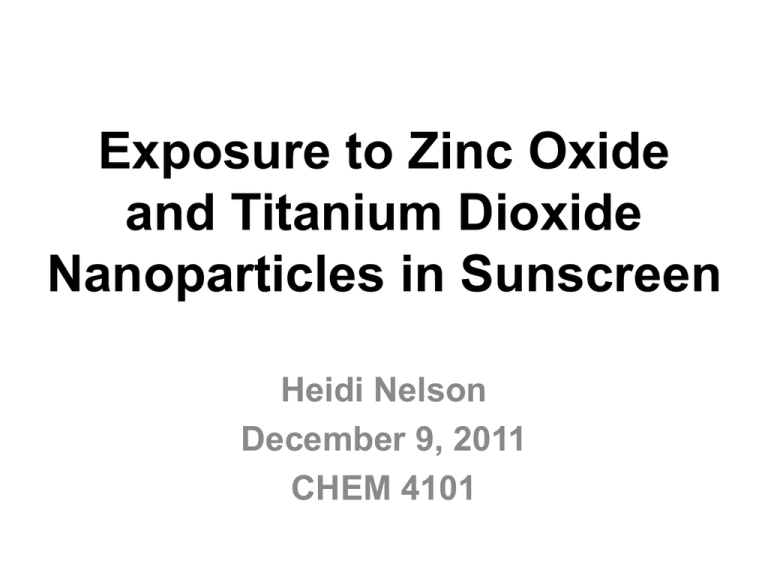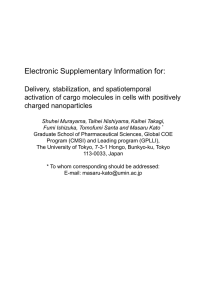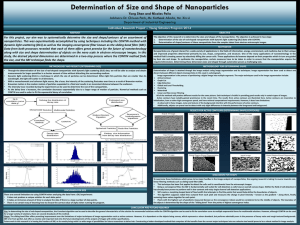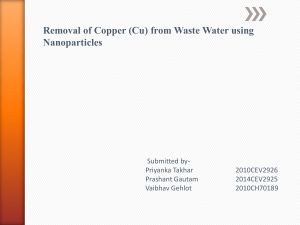
Exposure to Zinc Oxide
and Titanium Dioxide
Nanoparticles in Sunscreen
Heidi Nelson
December 9, 2011
CHEM 4101
Nanoparticles in Sunscreen
As the field of nanotechnology develops, nanoparticles
appear more frequently in consumer products. In
sunscreen, zinc oxide (ZnO) and titanium dioxide (TiO2)
nanoparticles are used to scatter ultraviolet light. The
advantage of these over larger particles is that sunscreen
containing nanoparticles is transparent when applied.
However, the potential health risks of exposure to
nanoparticles are largely unknown.1
ZnO nanoparticles and
sunscreen.
Consumer Reports,
www.consumerreports.org
Human subjects after application of sunscreen
containing nanoparticles (left) and sunscreen
containing larger particles (right). 1
Problem
When sunscreen containing
nanoparticles is used, do the
particles penetrate into human
skin? How far/how much?
Hypothesis
Nanoparticles will only
penetrate into the upper
layers of skin, and not in
significant amounts.
Cross section of pig skin labeled with
TiO2 particle distribution.2
Experiment
• Apply sunscreen containing ZnO and TiO2
nanoparticles to human subjects
– Monitor penetration of ZnO and TiO2 over time
– Controls: sunscreen with larger particles of ZnO
or TiO, sunscreen with no ZnO or TiO2
• Use an imaging technique to determine the depth of
nanoparticle penetration
• Use a quantitation technique to determine how
much ZnO/TiO2 is absorbed into skin
Imaging Techniques
Optical
microscopy
Fluorescence
confocal microscopy
Electron microscopy
(SEM/TEM)
Resolution
~100 nm
~100 nm
~1 nm
Background
UV scattering
UV scattering and skin
autofluorescence
No significant
interference from skin
Instrumentation Simple,
inexpensive
Intermediate cost and
complexity
Complex, expensive
In vivo imaging
Yes
Yes
No
Limitations
Limited imaging
depth
Restricted to
fluorescent materials
Intensive, destructive
sample preparation
References 3-4
Quantitative Techniques
Inductively coupled plasma-Mass spectrometry (ICP-MS)
• Measures atomic Zn and Ti
• Multiple peaks due to different isotopes
• Low background
• LOD: 0.1 to 10 ppb
Inductively coupled plasma-Atomic emission spectroscopy (ICP-AES)
• Measures atomic Zn and Ti
• Multiple peaks due to different energy transitions
• Potential high background
• LOD < 10 ppb
UV-vis absorbance
• Detects ZnO and TiO2 particles
• Optical properties depend on size/shape of particles
• Need to remove intact particles from skin matrix
• LOD is generally higher (can’t directly compare to atomic techniques)
References 5-6
Sample preparation
Fluorescence confocal microscopy3
• Virtually no preparation needed for non-invasive in vivo imaging
• Put drop of water, cover slip, immersion oil on skin
ICP-MS2,4
• Separate dermis and epidermis with dry heat (63 °C for two
minutes)
• Combine samples with 4:1 HNO3:HF
• Microwave dissolution for 35 minutes: 300 W, 200 °C, 220 psi
• Dilute with 2% HNO3
• Add Sc or Y internal standard
No chromatography or additional purification is necessary.
Fluorescence Confocal Microscopy
The excitation of ZnO and TiO2
fluorescence by two IR photons
(instead of one UV photon)
reduces scattering background
and increases imaging depth.
Nanoparticle fluorescence and
skin autofluorescence
background are collected
separately, using two detectors
with different filters. The focal
spot is scanned across the
sample and the two signals are
overlaid to create a contrast
image.3
Nikon Microscopy U, www.microscopyu.com
ICP-MS
Plasma containing
Ti and Zn ions
Ions sorted by
mass and charge
detector
Ar
Sample
in aq. HNO3
The sample is atomized and ionized in
an argon plasma. Ions are sorted by a
quadrupole mass analyzer. Their
concentrations are determined by
comparing signal intensity to an
internal standard.2,4
Agilent 7500a
LOD ~10 ppt
Linear range 9 orders of magnitude
Mass range 2-260 amu
http://www.chem.agilent.com/Library/Support/
Documents/F05009.pdf
Expected Results
Above: Fluorescence images of ZnO
nanoparticles, shown in red, in human skin
at different depths (scale bar 20 μm).3
Right: Levels of Ti from different types of
sunscreens measured by ICP-MS in the
epidermis (top) and dermis of pig skin.2
Conclusions
Fluorescence confocal microscopy is a suitable technique for
imaging ZnO and TiO2 nanoparticles in skin and determining the
depth of their penetration. Skin can be imaged in vivo at
different depths, and two-photon excitation reduces background.
ICP-MS is a suitable technique for quantifying the levels of Zn
and Ti present in skin. After microwave dissolution of skin
samples, these elements can be detected at low levels with few
interferences.
Previous papers with similar experiments showed results
consistent with my hypothesis, that nanoparticles penetrate skin
to relatively shallow depths and in relatively small amounts.
References
1. Wolf, L. K. Scrutinizing Sunscreens. Chem. Eng. News 2011, 89, 44-46.
2. Sadrieh, N. et al. Lack of Significant Dermal Penetration of Titanium Dioxide
from Sunscreen Formulations Containing Nano- and Submicron-Size TiO2
Particles. Toxicol. Sci. 2010, 115, 156-166.
3. Zvyagin, A. V. et al. Imaging of zinc oxide nanoparticle penetration in human
skin in vitro and in vivo. J. Biomed. Opt. 2008, 13, 064031.
4. Monteiro-Riviere, N. A. et al. Safety Evaluation of Sunscreen Formulations
Containing Titanium Dioxide and Zinc Oxide Nanoparticles in UVB
Sunburned Skin: An In Vitro and In Vivo Study. Toxicol. Sci. 2011, 123, 264280.
5. Contado, C.; Pagnoni, A. TiO2 in Commercial Sunscreen Lotion: Flow FieldFlow Fractionation and ICP-AES Together for Size Analysis. Anal.
Chem. 2008, 80, 7594-7608.
6. Skoog, D. A.; Holler, F. J.; Crouch, S. R. Principles of Instrumental Analysis,
6th ed., 2006.









